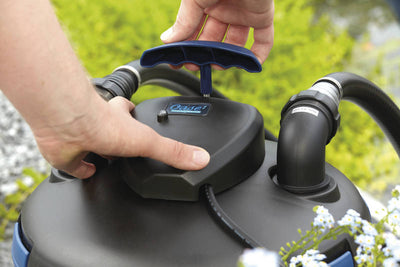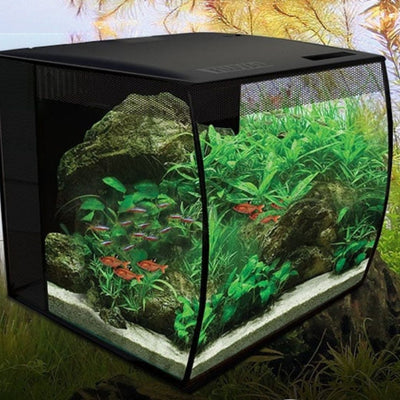
Welcome to the captivating world of aquascaping, where art and science merge to create stunning underwater landscapes that bring balance and harmony to your aquarium. Whether you're a seasoned aquarist or just starting out, unlocking the secrets of successful aquascaping can transform your tank into a mesmerizing work of art. By carefully selecting and arranging aquatic plants, rocks, and driftwood, you can create a natural and harmonious environment that not only pleases the eye but also promotes the well-being of your aquatic inhabitants. In this article, we will dive into the principles of aquascaping, exploring the essential elements and techniques that will help you master the art of creating a balanced and serene aquatic paradise. Get ready to unleash your creativity and discover the endless possibilities of aquascaping as we embark on this journey together. Let's dive in!
The Importance of Balance and Harmony in Aquariums
 Creating a balanced and harmonious environment in your aquarium is crucial for the health and well-being of your aquatic creatures. Just like in nature, a well-balanced aquarium provides a sense of tranquility and promotes the natural behaviours of its inhabitants. Achieving balance involves carefully considering the needs of your fish, plants, and other aquatic organisms, as well as the aesthetics of the overall setup. When a tank is in harmony, it becomes a thriving ecosystem where each element complements and supports the others. This balance not only enhances the visual appeal of your aquarium but also ensures the optimal growth and vitality of its inhabitants.
Creating a balanced and harmonious environment in your aquarium is crucial for the health and well-being of your aquatic creatures. Just like in nature, a well-balanced aquarium provides a sense of tranquility and promotes the natural behaviours of its inhabitants. Achieving balance involves carefully considering the needs of your fish, plants, and other aquatic organisms, as well as the aesthetics of the overall setup. When a tank is in harmony, it becomes a thriving ecosystem where each element complements and supports the others. This balance not only enhances the visual appeal of your aquarium but also ensures the optimal growth and vitality of its inhabitants.
To achieve balance and harmony, it's important to consider factors such as lighting, water parameters, and the selection of appropriate plants and hardscape elements. Proper planning and execution are key to creating an aquascape that mimics nature and captures the essence of a serene underwater world. By understanding the basic principles of aquascaping, you can create a visually pleasing and functional environment that brings joy to both you and your aquatic companions.
Basic Principles of Aquascaping
Aquascaping is both an art and a science that requires an understanding of design principles and the natural environment. To create a balanced and harmonious aquascape, there are several key principles to keep in mind. The first principle is the rule of thirds, which involves dividing the tank into imaginary thirds both horizontally and vertically. By placing the focal point or key elements of your aquascape along these lines, you can create a visually pleasing composition that guides the viewer's eye.
Another important principle is the use of contrasting elements. This can be achieved through the careful selection and placement of different plant species, colors, textures, and sizes. Contrasting elements add visual interest and depth to your aquascape, creating a sense of balance and harmony. It's also important to consider the concept of negative space, which refers to the empty or open areas in your aquascape. Negative space helps to highlight the focal point and creates a sense of balance by providing visual relief.
The third principle is the concept of the golden ratio, which is a mathematical ratio found in nature that is aesthetically pleasing to the human eye. By incorporating this ratio into your aquascape, you can create a visually pleasing and balanced composition. The golden ratio can be applied to the placement of rocks, driftwood, and other hardscape elements, as well as the layout of plants and open spaces.
Choosing the Right Plants for Your Aquascape
The selection of plants plays a crucial role in creating a balanced and harmonious aquascape. There are various types of aquatic plants to choose from, each with its own growth requirements and visual characteristics. When selecting plants, it's important to consider factors such as lighting, water parameters, and the overall theme or style of your aquascape.
Foreground plants are typically low-growing and are placed at the front of the tank to create a sense of depth and perspective. They provide a lush carpet-like appearance and help to anchor the aquascape. Popular foreground plants include Riccia, Eleocharis Acicularis Mini and Cuba. We recommend using tissue culture grown plants to achieve this.
Midground plants are taller than foreground plants and are placed in the middle of the tank. They act as a transition between the foreground and background, creating a sense of depth and adding visual interest. Examples of midground plants include Staurogyne repens, Echinodorus Bolivianus (Rusby) and Ammania Senegalensis
Background plants are typically taller and are placed at the back of the tank. They serve as a backdrop and help to create a sense of depth and perspective. Background plants can be used to hide equipment, provide shade, and create a natural-looking environment. Popular background plants include Cyperus Helferi, Hydrocotyle Leucocephala and Vallisneria Americana
Essential Equipment and Materials for Aquascaping
 In addition to selecting the right plants, having the right equipment and materials is essential for successful aquascaping. Here are some of the essential tools and materials you'll need to get started:
In addition to selecting the right plants, having the right equipment and materials is essential for successful aquascaping. Here are some of the essential tools and materials you'll need to get started:
1. Aquarium: Choose a tank size that suits your needs and provides ample space for your desired aquascape. Consider factors such as lighting requirements, filtration capacity, and ease of maintenance.
2. Substrate: The substrate provides a foundation for your plants and helps to anchor them in place. Choose a substrate that is suitable for the plants you have selected and provides the necessary nutrients
3. Lighting: Proper lighting is crucial for the growth and health of your aquatic plants. Select a lighting system that provides the right intensity and spectrum for the plants you have chosen.
4. Filtration: A good filtration system helps to maintain water quality and provides a healthy environment for your aquatic inhabitants. Choose a filter that suits the size of your tank and the needs of your fish and plants.
suits the size of your tank and the needs of your fish and plants.
5. CO2 System: Carbon dioxide (CO2) is an essential nutrient for plant growth. Consider adding a CO2 system to provide the necessary carbon dioxide for your aquatic plants.
6. Hardscape Materials: Rocks, driftwood, and other hardscape materials add structure and visual interest to your aquascape. Choose materials that are safe for your aquatic inhabitants and complement the overall theme of your tank.
Setting up the Aquarium for Optimal Balance
Before diving into aquascaping, it's important to set up your aquarium properly to ensure optimal balance and harmony. Here are some steps to follow:
1. Clean the tank: Start by thoroughly cleaning the tank to remove any dirt, debris, or residues that could negatively impact water quality.
2. Install the equipment: Set up the filtration system, lighting, and any other equipment you'll be using in your aquarium.
3. Add the substrate: Carefully add the substrate to the tank, making sure it is level and evenly distributed. The thickness of the substrate will depend on the type of plants you plan to grow.
4. Fill the tank with water: Fill the tank with water, taking care not to disturb the substrate. Use a water conditioner to remove any chlorine or other harmful chemicals from the tap water.
5. Cycle the tank: Allow the tank to cycle for several weeks to establish beneficial bacteria and stabilize water parameters. Regular testing of water parameters is essential during this process.
Once your tank is properly set up and cycled, you can begin the process of aquascaping and creating a visually stunning and balanced underwater landscape.
Techniques for Creating Depth and Perspective in Aquascapes
 Creating depth and perspective is essential for achieving a realistic and visually appealing aquascape. Here are some techniques you can use to create depth:
Creating depth and perspective is essential for achieving a realistic and visually appealing aquascape. Here are some techniques you can use to create depth:
1. Foreground to background: By placing smaller plants and hardscape elements in the foreground and gradually increasing the size as you move towards the background, you can create a sense of depth and perspective.
2. Layering: Use different layers of plants and hardscape materials to create depth and add visual interest. Combine different textures, colors, and sizes to create a visually appealing composition.
3. The rule of thirds: As mentioned earlier, the rule of thirds can be applied to the placement of focal points and key elements in your aquascape. By following this rule, you can create a visually pleasing composition that guides the viewer's eye.
4. Use of open spaces: Negative space, or open areas, can help create a sense of balance and depth in your aquascape. By leaving open spaces between plants and hardscape elements, you can create visual relief and highlight the focal points.
By incorporating these techniques into your aquascape, you can create a visually stunning and realistic underwater landscape that captivates viewers and provides a sense of depth and perspective.
Incorporating Hardscape Elements in Your Aquascape
Hardscape elements such as rocks, driftwood, and stones are essential for creating a visually appealing and balanced aquascape. These elements not only add structure and visual interest but also provide hiding places and territories for your aquatic inhabitants. Here are some tips for incorporating hardscape elements in your aquascape:
1. Choose the right materials: When selecting rocks, driftwood, or stones, choose materials that are safe for your fish and plants. Avoid materials that can alter water chemistry or leach harmful substances.
2. Consider the theme: The choice of hardscape materials should complement the overall theme or style of your aquascape. For example, using smooth rocks and driftwood can create a more natural and serene environment, while using rough and jagged rocks can create a more dramatic and dynamic aquascape.
3. Placement: Experiment with different placements and arrangements of rocks, driftwood, and stones to create a visually pleasing composition. Consider the rule of thirds and the golden ratio when placing these elements.
4. Create hiding places: Hardscape elements can provide hiding places for shy or territorial fish. By creating caves, overhangs, or crevices, you can provide a sense of security for your aquatic inhabitants.
Remember to take your time and experiment with different arrangements and placements until you achieve the desired effect. Hardscape elements can greatly enhance the visual appeal and functionality of your aquascape.
Maintenance and Care for a Balanced Aquarium
Maintaining a balanced and harmonious aquarium requires regular care and attention. Here are some maintenance tips to keep your aquascape thriving:
1. Water changes: Regular water changes are essential for maintaining water quality and removing excess nutrients and waste. Aim for a weekly water change of 10-20% to keep your aquarium in optimal condition.
2. Pruning and trimming: Aquatic plants require regular pruning and trimming to prevent overgrowth and maintain their desired shape. Remove any dead or decaying plant material to prevent the buildup of harmful bacteria.
3. Algae control: Algae can quickly overtake your aquascape and disrupt the balance of your aquarium. Regularly clean glass surfaces, remove any visible algae, and ensure proper lighting and nutrient levels to prevent algae growth.
4. Monitor water parameters: Regularly test water parameters such as pH, ammonia, nitrite, and nitrate levels to ensure they are within the appropriate range for your fish and plants. Adjust water parameters as needed.
5. Fish and plant health: Regularly observe your fish and plants for signs of health issues or stress. Address any issues promptly to prevent them from spreading and affecting the overall balance of your aquarium.
By following these maintenance tips and keeping a close eye on the health of your aquatic inhabitants, you can ensure that your aquascape remains balanced, healthy, and visually stunning.
Showcasing Successful Aquascapes and Gaining Inspiration
One of the best ways to gain inspiration and learn more about aquascaping is by studying successful aquascapes created by experienced aquarists. There are various online forums, social media groups, and websites dedicated to showcasing stunning aquascapes from around the world. Take the time to explore these resources and gain inspiration from the creativity and expertise of others.
Attending aquascaping competitions and workshops is another great way to learn from experts and gain insights into the latest trends and techniques. These events provide an opportunity to interact with fellow aquarists, ask questions, and receive valuable feedback on your own aquascape.
Remember, while it's important to gain inspiration from others, it's equally important to develop your own style and express your creativity. Use the knowledge and techniques you've learned to create unique and personalised aquascapes that reflect your own vision and passion.
Final Tips for Achieving Balance and Harmony in Your Aquarium
Achieving balance and harmony in your aquarium is a journey that requires patience, creativity, and a deep understanding of the natural environment. By applying the principles of aquascaping, carefully selecting and arranging plants and hardscape elements, and maintaining regular care and attention, you can create a visually stunning and balanced aquascape that brings joy and tranquility to both you and your aquatic companions.
Here are some final tips to keep in mind:
- Experiment and have fun: Aquascaping is a creative and ever-evolving process. Don't be afraid to experiment with different plants, hardscape elements, and techniques. Embrace the process and enjoy the journey.
- Research and learn: Continuously educate yourself about aquascaping techniques, plant care, and the needs of your aquatic inhabitants. Stay up to date with the latest trends and developments in the field.
- Be patient: Creating a balanced and harmonious aquascape takes time and patience. Allow your aquascape to evolve and grow naturally, making adjustments as needed.
- Take care of yourself: Remember to take care of yourself while caring for your aquarium. Regularly take breaks, practice self-care, and enjoy the peaceful and therapeutic benefits of aquascaping.
© weknowpets 2023









